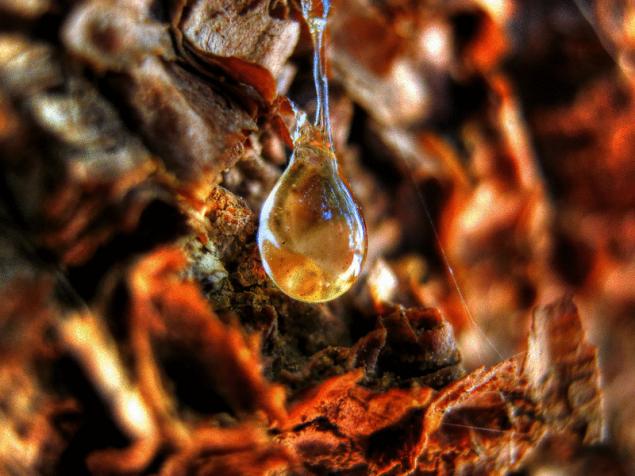SAP: useful properties
 Bashny.Net
Bashny.Net
Oleoresin turpentine or otherwise, is a very fragrant sticky resinous substance that is naturally secreted when damage to the bark of coniferous trees.

During solidification on the surface of the bark oleoresin forms a reliable protective barrier that protects the wounded tree from the likely penetration of bark beetles-pests or pathogens.
The beneficial properties of resin are relevant not only for the trees themselves, but also for humans. That is why this natural substance thanks to its unique composition and broad spectrum of medicinal properties, long actively used for prevention and treatment of many diseases in traditional medicine of different countries.
The types of resin
The types of resin directly depend on what kind of tree removed this resinous substance. So, to distinguish the turpentine pine, spruce, cedar, fir, as well as the resin obtained from the larch. All of these varieties are not particularly distinguished from each other by biochemical composition and for its medicinal properties.
The composition of resin
However, in the resin composition of any of all types of mandatory volatiles (monoterpenes), which produce turpentine and diterpene and sesquiterpenes along with their derivatives. In addition, the resin present in the resin (rezinovye acid), among which abietina, digidrotahisterola, dextromethrophan, lambertiana, levopimaric, palustria, pilarova, Sapunova and others. They form when boiling rosin resin.
Additionally, the composition of resin resin discovered colorless spirits retinol, resentingly (ie colored alcohols, which reproduce the reaction of the tannic substances), complex resin esters of rubber, vitamins D and C, succinic acid, fatty acids and some impurities of vegetable origin.
The use of resin
The use of resin to human health were known to the inhabitants of Ancient Greece, which used the SAP as food in various disorders of the digestive processes. In addition, this useful substance was often used to treat diseases of the lungs and kidneys, various injuries, rheumatism and diseases of the skin.
Traditional Chinese medicine says the absolute benefit of resin not only in the treatment of the above diseases, but also as an effective herbal remedy that helps to get rid of dental and headaches.
The harm of turpentine
However, I must say that this precious resin has a number of contraindications. In particular, damage of the resin can be felt, first of all, people with individual intolerance of the product, causing allergic reactions. In addition, the resin, as well as therapeutic and prophylactic tools based on it is not recommended for use by women during pregnancy and children under the age of twelve years.published
P. S. And remember, only by changing their consumption — together we change the world! ©
Source: www.ecology.md

During solidification on the surface of the bark oleoresin forms a reliable protective barrier that protects the wounded tree from the likely penetration of bark beetles-pests or pathogens.
The beneficial properties of resin are relevant not only for the trees themselves, but also for humans. That is why this natural substance thanks to its unique composition and broad spectrum of medicinal properties, long actively used for prevention and treatment of many diseases in traditional medicine of different countries.
The types of resin
The types of resin directly depend on what kind of tree removed this resinous substance. So, to distinguish the turpentine pine, spruce, cedar, fir, as well as the resin obtained from the larch. All of these varieties are not particularly distinguished from each other by biochemical composition and for its medicinal properties.
The composition of resin
However, in the resin composition of any of all types of mandatory volatiles (monoterpenes), which produce turpentine and diterpene and sesquiterpenes along with their derivatives. In addition, the resin present in the resin (rezinovye acid), among which abietina, digidrotahisterola, dextromethrophan, lambertiana, levopimaric, palustria, pilarova, Sapunova and others. They form when boiling rosin resin.
Additionally, the composition of resin resin discovered colorless spirits retinol, resentingly (ie colored alcohols, which reproduce the reaction of the tannic substances), complex resin esters of rubber, vitamins D and C, succinic acid, fatty acids and some impurities of vegetable origin.
The use of resin
The use of resin to human health were known to the inhabitants of Ancient Greece, which used the SAP as food in various disorders of the digestive processes. In addition, this useful substance was often used to treat diseases of the lungs and kidneys, various injuries, rheumatism and diseases of the skin.
Traditional Chinese medicine says the absolute benefit of resin not only in the treatment of the above diseases, but also as an effective herbal remedy that helps to get rid of dental and headaches.
The harm of turpentine
However, I must say that this precious resin has a number of contraindications. In particular, damage of the resin can be felt, first of all, people with individual intolerance of the product, causing allergic reactions. In addition, the resin, as well as therapeutic and prophylactic tools based on it is not recommended for use by women during pregnancy and children under the age of twelve years.published
P. S. And remember, only by changing their consumption — together we change the world! ©
Source: www.ecology.md
Tags
See also
The needles of spruce useful properties and contraindications
Useful properties of celandine
Treatment of MILLET in traditional medicine: pancreatitis, liver disease, gall bladder and not only!
Treatment with Rosa in folk medicine
Recipes of traditional medicine to enhance immunity
Useful properties of potato juice
Useful properties of chamomile
Buckwheat in folk medicine!
GOLDEN recipes of folk medicine

















